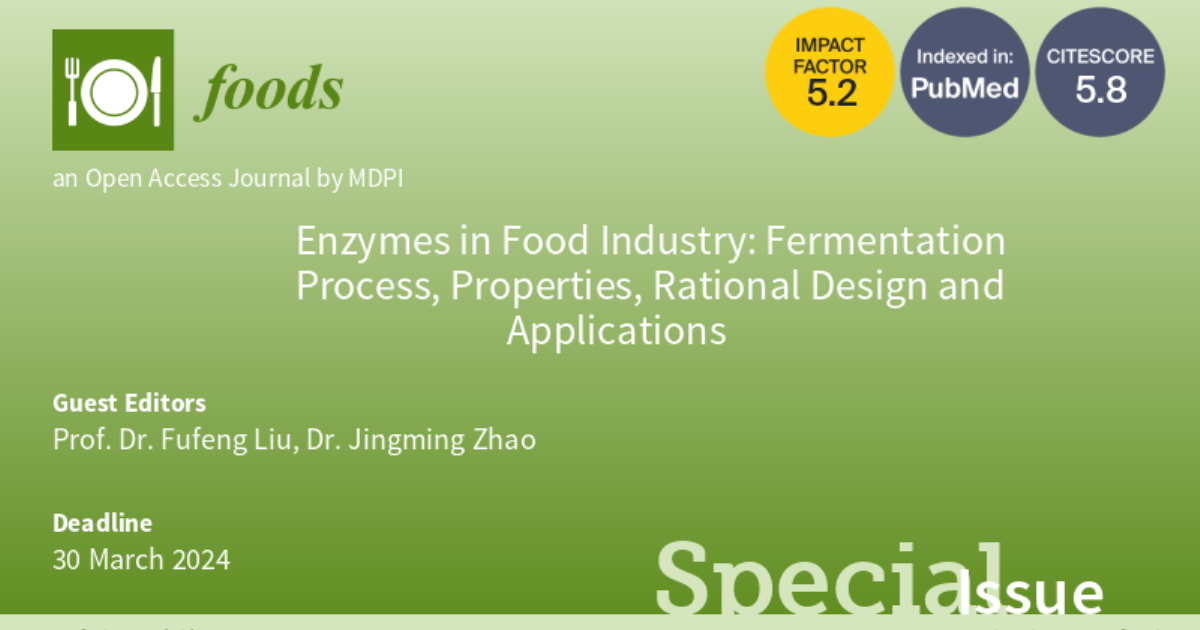Enzymes in Food Industry: Fermentation Process, Properties, Rational Design and Applications
A special issue of Foods (ISSN 2304-8158). This special issue belongs to the section "Food Biotechnology".
Deadline for manuscript submissions: closed (30 June 2024) | Viewed by 11679

Special Issue Editors
Interests: enzyme; functional food; rational design; molecular simulation
Special Issues, Collections and Topics in MDPI journals
Interests: metalloenzymes; biocatalysis; protein engineering; enzyme mechanisms
Special Issues, Collections and Topics in MDPI journals
Special Issue Information
Dear Colleagues,
As common bio-macromolecular catalysts, enzymes are widely used in food preparation for improving the taste and texture of food products. More importantly, enzymes perform a crucial role in producing bioactive compounds, important food ingredients and some new nutritional ingredients, which can improve food quality and function. In this Special Issue, we welcome original research or review manuscripts that cover the utility of free enzymes and/or immobilized enzymes as efficient tools that can be applied to various aspects of the food industry. Specifically, novel enzyme mining, the structure–function relationship of enzymes, and the immobilization and modification of enzymes will be a focus. In addition, the development of novel enzymes for creating new food components and rational design of food enzymes are strongly encouraged.
Prof. Dr. Fufeng Liu
Dr. Jingming Zhao
Guest Editors
Manuscript Submission Information
Manuscripts should be submitted online at www.mdpi.com by registering and logging in to this website. Once you are registered, click here to go to the submission form. Manuscripts can be submitted until the deadline. All submissions that pass pre-check are peer-reviewed. Accepted papers will be published continuously in the journal (as soon as accepted) and will be listed together on the special issue website. Research articles, review articles as well as short communications are invited. For planned papers, a title and short abstract (about 100 words) can be sent to the Editorial Office for announcement on this website.
Submitted manuscripts should not have been published previously, nor be under consideration for publication elsewhere (except conference proceedings papers). All manuscripts are thoroughly refereed through a single-blind peer-review process. A guide for authors and other relevant information for submission of manuscripts is available on the Instructions for Authors page. Foods is an international peer-reviewed open access semimonthly journal published by MDPI.
Please visit the Instructions for Authors page before submitting a manuscript. The Article Processing Charge (APC) for publication in this open access journal is 2900 CHF (Swiss Francs). Submitted papers should be well formatted and use good English. Authors may use MDPI's English editing service prior to publication or during author revisions.
Keywords
- enzyme engineering
- enzyme
- food industry
- enzyme activity
- enzyme immobilization
- biocatalysts
- enzymatic modification
- enzyme design
- food ingredients
- functional food
- bioactive compounds
- enzyme stability
- molecular simulation
- structure–function relationship
Benefits of Publishing in a Special Issue
- Ease of navigation: Grouping papers by topic helps scholars navigate broad scope journals more efficiently.
- Greater discoverability: Special Issues support the reach and impact of scientific research. Articles in Special Issues are more discoverable and cited more frequently.
- Expansion of research network: Special Issues facilitate connections among authors, fostering scientific collaborations.
- External promotion: Articles in Special Issues are often promoted through the journal's social media, increasing their visibility.
- e-Book format: Special Issues with more than 10 articles can be published as dedicated e-books, ensuring wide and rapid dissemination.
Further information on MDPI's Special Issue polices can be found here.







